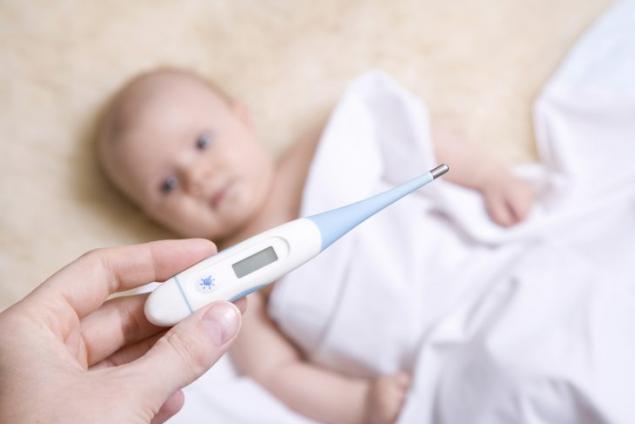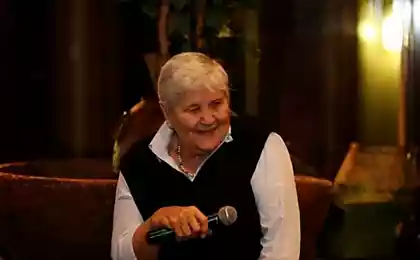3910
This need to know! 12 important facts about the heat in the child
Everyone knows that a strong increase in body temperature is very dangerous for health, but what exactly it threatens us? How exactly the temperature can harm us? And how to behave in case of fever and fever? < Website publish a detailed and fascinating guide to a high temperature, written by Robert Mendelsohn, the largest American pediatrician, author of the book "How to grow a healthy baby despite the doctors».

When you call your doctor to report about the child's illness, the first question that he almost always asks: "The temperature is measured?" And then, no matter what data you tell it - 38 or 40 degrees, advises to give a child aspirin, and bring it to the reception. It has become a ritual almost all pediatricians. I suspect that many of them say memorized phrases, even if they hear about a temperature of 43 degrees.
My concern is that the children's doctors asked the wrong questions and give wrong advice. As the temperature rises the doctors seen something extremely dangerous, or why it is their first concern? And from their advice parents give a child aspirin inevitably conclude that treatment should be aimed at the medical and temperature reduction.
Body temperature measurement and recording its performance in medical record begins reception in most children's hospitals. There is nothing wrong. Fever, indeed, is an important diagnostic sign in the context of follow-up survey. The problem is that it is given more importance than would be necessary. When the doctor sees in a map nurse record temperature of, say, 39, 5 degrees, he grimly invariably says, "Wow! We must do something!. »
His concern about the temperature - nonsense and misleading nonsense! With the rise in temperature on its own does not have to do anything yourself. In the absence of other symptoms, such as unusual behavior, especially weakness, shortness of breath and other, to suggest serious diseases like diphtheria and meningitis, the doctor must tell parents that nothing to worry about, and send them home with your child.
Taking into account the exaggerated attention of physicians to an elevated temperature, it is not surprising that the majority of parents, according to opinion polls, are experiencing great fear in front of her. And this fear is growing in proportion to the indications of the thermometer, while he often bespochven
Here are twelve facts relating to body temperature, the knowledge of which will help you avoid a lot of excitement, and your children -. Unnecessary and dangerous analyzes, radiological examinations and medication. These facts must be taken into account every physician, but many pediatricians prefer to ignore them and do not consider it necessary to acquaint them with their parents.
fact № 1. temperature of 37 degrees It is not "normal" for everyone, as we repeat the whole life. This is simply not true. The established "norm" rather conventional, as figure 37 degrees - the value of the average. In many people the normal temperature is higher or lower. This applies particularly to children. Investigations revealed that the body temperature in the majority of absolutely healthy children 35, 9-37, 5 degrees and only a few - just 37 degrees
. Fluctuations in the baby's body temperature during the day can be substantial: it is the evening on a degree higher than in the morning. Finding the child in the afternoon slightly elevated temperature, do not worry. For this time of day it is quite normal
Fact № 2. The temperature can rise for reasons not related to any disease:. in the digestion of copious and heavy meals or at the time of ovulation teenage girls in their puberty period. Sometimes the temperature rise is a side effect of prescription drugs a doctor -. Antihistamines and other
Fact № 3. temperature, which is to be feared, usually has an obvious cause In most cases, an increase in temperature, which can. pose a threat to health, there is either a result of poisoning by toxic substances, or as a result of overheating (the so-called heat stroke).
Classic examples of overheating - the soldiers fainted on parade or a marathon runner, coming down from the race and falling from exhaustion in the hot sun. In such cases, the temperature may rise to 41, 5 degrees or higher, which is fraught with disastrous consequences for the organism. A similar effect can be achieved and overheated beyond measure in the bath or in the jacuzzi.
If you suspect that a child has swallowed a poisonous substance, immediately call in the help center for poisoning. When this is not possible, without waiting for trouble, immediately Bring the child to the hospital and, if possible, grab the pack of tools swallowed - it will quickly pick up the antidote
. As a rule, children ingested substances are relatively harmless, but the timely recourse is very important.
Immediate within is also necessary if the child loses consciousness, even briefly, after the outdoor games in summer or after a bath or jacuzzi. Bell doctor in this situation insufficient. As soon as possible Bring the child to the hospital. External influences are potentially dangerous. They are able to suppress the body's defenses, which under normal conditions do not allow the temperature to rise to dangerous levels. Recognize these states to help them to events preceding and accompanying symptoms. I stress: loss of consciousness means that the child is in danger
Fact № 4. reading of body temperature depends on the method of measurement rectal (rectal) temperature in children is usually a degree higher.. than oral (mouth), axillary - a degree lower. However, in infants is the difference between the temperature values measured by these methods, is not so great, so it is better to measure the temperature in the armpit.
Use a rectal thermometer, I do not advise: when administered possible perforation of the rectum, and it is fatal in half of the cases. Why take the risk when it is not needed? Finally, do not assume that the child's body temperature can be determined by feel, touching the forehead or chest. It can not be any health professionals, nor you.
Fact № 5. Shoot down the body temperature should not be. The only exceptions are infants suffering from infections caused by obstetric intervention is often in childbirth , intrauterine and hereditary diseases. Acute infectious disease can be the result and some of the procedures. For example, an abscess under the scalp may occur in the baby unit from the sensors during prenatal monitoring, and aspiration pneumonia - due to the amniotic fluid trapped in the lungs as a result of the introduction of the mother during labor and delivery of drugs. Infection infection is possible during the circumcision procedure: in hospitals legions of pathogens (this is just one of the reasons that my grandchildren were born at home). If the baby in the first months of life, high fever, show it to your doctor just need.
Fact № 6. temperature could rise by over-wrapping. Children are very sensitive to overheating. Parents, especially first-borns are often too concerned about whether their children's cold. They wrapped up the kids in a variety of clothes and blankets, forgetting that if he gets hot, he can not get rid of your own warm clothes. If the baby has a fever, do not forget to check whether it is not too warmly dressed.
If a child with temperature, especially accompanied by a fever, tightly wrapped in thick blankets, it will provoke even greater its rise. A simple rule which I recommend to parents of their patients: even for a child to be so many layers of clothing as they themselves
Fact number 7
Most.. cases rise in temperature is due to viral and bacterial infections, which the body's defenses to cope without any help Colds and flu -. the most common causes of temperature increase in children of any age. The temperature can rise to 40, 5 degrees, but even in this case there is no reason to worry.
The only danger - the risk of dehydration associated processes sweating, rapid pulse and breathing, coughing, vomiting and diarrhea. It can be avoided by giving the child plenty to drink. It would be nice if the baby drink every hour a glass of liquid, preferably nutritious. It can be a fruit juice, lemonade, tea and everything from which the child will not give up. In most cases, viral and bacterial infections are easily identified by a concomitant increase in the temperature of the symptoms: slight cough, runny nose, watery eyes and so on. In these diseases do not need a doctor's care or any medication. The doctor can not "prescribe" is nothing more effective than the body's defenses. Drugs that facilitate the general condition, only interfere with the action of the vital forces. That's what I tell in more detail in a later chapter.
We do not need antibiotics, and although they may shorten the duration of a bacterial infection, but the risk associated with them is very large
Fact № 8. There is no unambiguous relationship between the child's body temperature and severity of the disease strong.. > A common misconception regarding this in no way justified. In addition, no consensus on what constitutes a "high temperature", no parents, nor even among doctors. The parents of my patients, and I had them very much, have in this respect diametrically opposed views. Studies have shown that more than half of parents surveyed think "high" temperature of 37, 7 to 38, 8 degrees and almost all is the temperature 39 degrees 5 "very high." In addition, all respondents were convinced that the high temperature indicates the severity of the disease.
It's not like that at all. More precisely, the bounds, the measured temperature is absolutely nothing to say about the severity of the disease, if it is caused by a viral or bacterial infection. Once you understand that the reason for the temperature - an infection, stop to measure the temperature every hour. Tracing its increase in such diseases do not help, moreover, it will only exacerbate your fears and weary child.
Some common, benign diseases such as measles a day, children sometimes cause a very high temperature, while others are more serious, it may occur without increase. If additional symptoms such as vomiting or difficulty breathing No, stay calm. Even if the temperature rises to 40, 5 degrees.
To determine a light, like a cold or severe, such as meningitis, a disease caused by the temperature, it is important to consider the overall condition of the child, his behavior and appearance. All these points you will appreciate much better than the doctor. Where are you better know how your child usually looks like and how it behaves. If there is an unusual lethargy, confusion, and other alarming symptoms, which continue a day or two, it makes sense to call the doctor. If a child is active, he did not change his behavior, reason to fear that he is seriously ill, no.
From time to time in the pediatric journals come across articles about "temperaturofobii" - of the parent unreasonable fear of high temperature in children. Doctors specially invented this term - is typical of people in my profession tactics of "blaming the victim" doctors are never wrong, and if errors occur, all the fault of the patients. In my opinion, "temperaturofobiya" - disease pediatricians, not parents. And that doctors blame for the fact that parents become its victims.
Fact № 9. temperature caused by a viral or bacterial infection, if not knock down, will not rise above 41 degrees. Pediatricians a disservice by prescribing antipyretics. As a result of their parents' anxiety prescriptions that the temperature can rise to the extreme, if you do not take action, supported and strengthened. Doctors do not say that the temperature in the knocking down the healing process is not affected, as well as the fact that the human body has a mechanism (not yet fully explained), which does not allow the temperature to overcome the barrier of 41 degrees.
Only if heat stroke, poisoning and other external influences, this natural mechanism may not work. In such cases, the temperature rises above 41 degrees. Doctors are aware of this, but most of them pretend that they do not know. I believe that their behavior is motivated by a desire to demonstrate their care for a child. In addition, there is shown a general tendency for doctors to intervene in any situation and the reluctance to recognize that states exist, they are not able to be treated effectively. Apart from the cases fatal, incurable disease, a doctor will dare to say to the patient: "I can not do anything»
Fact № 10. Measures to reduce the temperature, whether the use of antipyretics or sponging with water, not only? do not need, but also harmful. If your child is infected, the rise in temperature that accompanies the disease, parents should be seen not as a curse but as a blessing. The temperature rises spontaneously as a result of generating pyrogen - substances that cause fever. This is the body's natural defense against disease. An increase in temperature indicates that the body's healing system turned on and working.
The process develops as follows: an infectious disease the child's body reacts to the elaboration of additional white blood cells - white blood cells. They kill bacteria and viruses and cleanse the body of damaged tissue and debris. leukocyte activity it increases, they quickly move to the site of infection. This part of the process, the so-called leykotaksis, just stimulates the production of pyrogenic raising body temperature. Fever suggests that the healing process is accelerated. It is not necessary to be afraid, it is necessary to be happy.
But that is not all. Iron, which provides power for a variety of bacteria, leaving the blood and accumulated in the liver. This reduces the rate of bacterial growth and enhances the effectiveness of interferon produced by the body to fight disease.
This process has been demonstrated in laboratory experiments scientists on infected animals. When the temperature rises artificial mortality of experimental animals from infection decreased, while with decreasing - increased. Artificial fever has long been used in cases where the patient's body lost its natural ability that in diseases.
If the baby's temperature has risen as a result of infection, do not be tempted to run her medications or sponging. Allow the temperature to do their job. Well, if your compassion required to facilitate the patient's condition, give your child paracetamol dosage appropriate age or wipe the body with warm water. This is quite enough. The doctor only when the temperature is more than three days, there were other symptoms or the child became very ill
I emphasize:. Reducing the temperature to relieve the child's condition, you are interfering with the natural process of healing
. If you do not bring down the temperature, you can not, sponging with water is preferable taking aspirin and paracetamol because of their danger. Despite the popularity of these funds is far from harmless. Aspirin poisoning each year, probably more children than any other poison. This is the same form of salicylic acid, which is used as the basis of an anticoagulant in rat poison - rat eating it, die from internal bleeding
. Aspirin can cause a number of side effects in children and adults. One of them are intestinal bleeding. If children get this medication during the flu or chicken pox disease, they can also develop Reye's syndrome - a common cause of infant mortality, mainly due to the impact on the brain and liver. Partly for that reason, many doctors switched to aspirin to paracetamol (acetaminophen, Panadol, kalpol and others).
Acceptance of this tool is also not way out. There is evidence that high doses of this drug is toxic to the liver and kidneys. Обращу ваше внимание и на то, что дети, чьи матери принимали аспирин во время родов, часто страдают от кефалогематомы — состояния, при котором на голове появляются наполненные жидкостью шишки.
Если вы все же решили снизить температуру тела ребенка обтиранием, используйте только теплую воду. Снижение температуры тела достигается испарением воды с кожи и от температуры воды не зависит. Вот почему слишком холодная вода преимуществ не имеет. Не подойдет для обтирания и спирт: его пары для малыша токсичны.
Факт № 11.Высокая температура, вызванная вирусной или бактериальной инфекцией, не приводит к поражению мозга и не вызывает иных отрицательных последствий. Страх высокой температуры во многом исходит из широко распространенного представления, что она может привести к необратимому поражению мозга или иных органов. Если бы это было так, паника родителей при повышении температуры была бы оправданной. Но, как я уже сказал, утверждение это ложное.
Тем, кому знаком этот страх, советую забыть обо всем, что его посеяло, и никогда не принимать на веру слов о такой угрозе высокой температуры, от кого бы они ни исходили — от других родителей, пожилых людей или знакомого доктора, дружески раздающего советы за чашкой кофе. И даже если такой совет дала всезнающая бабушка. Права она бывает, увы, не всегда. Простуда, грипп и любая другая инфекция не поднимут температуру тела ребенка выше 41 градуса, а температура ниже этого уровня не причинит долгосрочного вреда.
Не нужно каждый раз подвергать себя страху возможного поражения мозга у ребенка при повышении у него температуры: защитные силы организма не позволят температуре подняться выше 41 градуса. Не думаю, что даже педиатрам, практиковавшим десятилетиями, приходилось видеть больше одного-двух случаев с высокой температурой. Подъем температуры выше 41 градуса вызывается не инфекцией, а отравлением или перегревом. Я лечил десятки тысяч детей и только один раз наблюдал у своего пациента температуру выше 41 градуса. Это неудивительно. Исследования показали, что в 95 процентах случаев повышения температуры у детей она не поднималась выше 40, 5 градусов.
Факт № 12.Высокая температура не вызывает судороги. Их вызывает резкий подъем температуры. Многие родители боятся высокой температуры у своих детей, поскольку заметили, что ей сопутствуют приступы судорог. Они полагают, что судороги вызывает «слишком высокая» температура. Я хорошо понимаю таких родителей: ребенок в судорогах — зрелище невыносимое. Тем, кто такое наблюдал, возможно, будет трудно поверить, что, как правило, это состояние не бывает серьезным. Кроме того, оно относительно редкое — лишь у 4 процентов детей с высокой температурой наблюдаются судороги, и нет свидетельств того, что они оставляют серьезные последствия.
Исследование 1 706 детей, испытавших фебрильные судороги, не обнаружило случаев нарушения моторики и не зафиксировало смертельных исходов. Не существует также и убедительных доказательств того, что такие судороги повышают впоследствии риск эпилепсии.
Более того, меры по предотвращению фебрильных судорог — прием жаропонижающих препаратов и обтирание — почти всегда осуществляются слишком поздно и, следовательно, впустую: к моменту обнаружения высокой температуры у ребенка, чаще всего, судорожный порог уже пройден. Как я уже говорил, судороги зависят не от уровня температуры, а от скорости ее подъема до высокой отметки. Если температура резко поднялась, судороги либо уже произошли, либо опасность их миновала, то есть предотвратить их практически невозможно.
К фебрильным судорогам обычно склонны дети до пяти лет. Дети, испытывавшие такие судороги в этом возрасте, в последующем страдают ими редко. Для предотвращения повторения судорог при высокой температуре многие врачи назначают детям долгосрочное лечение фенобарбиталом и другими противосудорожными препаратами. Если такие средства пропишут вашему ребенку, расспросите врача о риске, связанном с ними, и о том, к каким изменениям в поведении ребенка они ведут.
Вообще же, в вопросе долговременного лечения фебрильных судорог единогласия среди врачей нет. Лекарства, которые обычно используются в этом случае, вызывают поражение печени и даже, как показали опыты на животных, негативно воздействуют на мозг. Один из авторитетов в данном вопросе однажды заметил: «Иногда пациенту полезнее жить обычной жизнью между эпизодами судорог, нежели жить на лекарствах без судорог, но в постоянном состоянии сонливости и спутанности сознания…».
Меня учили прописывать детям с фебрильными судорогами (для предотвращения их повторения) фенобарбитал, нынешних студентов-медиков учат тому же. Сомнение в правильности назначения этого препарата у меня возникло тогда, когда я заметил, что при лечении им у некоторых пациентов судороги повторялись. Это, естественно, заставило задуматься: благодаря ли фенобарбиталу у остальных пациентов они прекратились? Мои подозрения усилились после жалоб некоторых матерей на то, что препарат перевозбуждает детей или затормаживает настолько, что, обычно активные и общительные, они внезапно превращаются в полузомби. Так как судороги эпизодичны и не оставляют длительных последствий, я перестал прописывать это лекарство своим маленьким пациентам.
Если испытывающему фебрильные судороги ребенку пропишут долговременное лечение, родителям придется решить, соглашаться на него или нет. Я понимаю, что открыто выражать сомнения в назначениях врача непросто. Знаю и то, что врач может отмахнуться от расспросов или не дать вразумительных ответов. Если так и случится, нет смысла затевать спор. Надо взять у доктора рецепт и, прежде чем покупать лекарство, попросить совета у другого врача.
Если у вашего ребенка начались связанные с температурой судороги, постарайтесь не паниковать. Конечно, советы давать куда проще, чем им следовать. Зрелище ребенка с судорогами действительно пугает. И все же: напомните себе, что судороги не угрожают жизни вашего малыша и не принесут необратимого вреда, и примите простые меры к тому, чтобы ребенок не пострадал во время приступа.
Первым делом поверните ребенка набок, чтобы он не захлебнулся слюной. Затем проследите, чтобы возле его головы не было твердых и острых предметов, которыми он может пораниться во время приступа. Убедившись, что дыханию малыша ничего не препятствует, поместите твердый, но не острый предмет между его зубами — например, чистую сложенную кожаную перчатку или бумажник (не палец!), чтобы он случайно не прикусил язык. После этого, для собственного успокоения, можете позвонить врачу и рассказать о том, что случилось.
По большей части судороги длятся несколько минут. Если они затянутся, спросите по телефону совета врача. Если после приступа судорог ребенок не уснет, давать ему еду и питье нельзя в течение часа. Из-за сильной сонливости он может подавиться.
Краткое руководство по температуре телаВысокая температура — часто встречающийся у детей симптом, не связанный с тяжелыми болезнями (в отсутствие других тревожных симптомов, таких как необычные вид и поведение, затруднение дыхания и потеря сознания). Она не является показателем тяжести заболевания.
Температура, повышающаяся в результате инфекции, не достигает значений, при которых возможны необратимые поражения органов ребенка.
Повышенная температура не требует медицинского вмешательства сверх того, что рекомендовано ниже. Температуру не нужно сбивать. Она является естественной защитой организма от инфекции и помогает скорейшему исцелению.
1. Если температура тела у ребенка до двух месяцев поднялась выше 37, 7 градусов, обратитесь к врачу. Это может быть симптомом инфекции — внутриутробной или связанной с вмешательством в процесс родов. Повышенная температура у детей такого возраста настолько необычна, что благоразумнее подстраховаться и скорее успокоиться, если тревога окажется ложной.
2. Для детей старше двух месяцев врач при повышении температуры не нужен, кроме случаев, когда температура держится более трех дней или сопровождается серьезными симптомами — рвотой, затрудненным дыханием, сильным кашлем в течение нескольких дней и другими, не характерными для простуды. Посоветуйтесь с врачом, если ребенок необычно вял, раздражителен, рассеян или выглядит серьезно больным.
3. Обращайтесь к врачу независимо от показаний термометра, если у ребенка трудности с дыханием, неукротимая рвота, если температура сопровождается непроизвольными подергиваниями мышц или другими странными движениями или беспокоит что-то еще в поведении и виде ребенка.
4. Если подъем температуры сопровождается ознобом, не пытайтесь справиться с этим ощущением ребенка с помощью одеяла. Это приведет к еще более резкому повышению температуры. Озноб не опасен — это нормальная реакция организма, механизм приспособления к более высокой температуре. Он не означает, что ребенку холодно.
5. Попытайтесь уложить температурящего ребенка в постель, но не переусердствуйте. Нет никакой необходимости приковывать ребенка к кровати и держать его дома, если погода не слишком плохая. Свежий воздух и умеренная активность улучшат настроение малыша, не ухудшая состояния, и облегчат вам жизнь. Однако слишком интенсивные нагрузки и спортивные состязания поощрять не надо.
6. Если есть основания подозревать в качестве причины высокой температуры не инфекцию, а другие обстоятельства — перегрев или отравление, везите ребенка в больницу немедленно. Если в вашей местности нет отделения скорой помощи, пользуйтесь любой доступной медицинской помощью.
7. Не пытайтесь, по народной традиции, «заморить голодом лихорадку». Питание важно для выздоровления от любой болезни. Если ребенок не оказывает противодействия, «закармливайте» и простуды, и лихорадки. И те, и другие сжигают запасы белков, жиров и углеводов в организме, и их нужно возмещать. Если ребенок отказывается есть, поите его питательными жидкостями, например фруктовым соком. И не забывайте, что куриный суп полезен всем.
Высокая температура и обычно сопутствующие ей симптомы приводят к существенной потере жидкости и вызывают обезвоживание. Его можно избежать, давая ребенку много пить, лучше всего — фруктовые соки, но, если он их не захочет, подойдет любая жидкость, желательно — по одному стакану каждый час.
Из книги Роберта Мендельсона «Как вырастить ребенка здоровым вопреки врачам».
via fithacker.ru/articles/eto-neobhodimo-znat-12-faktov-o-vyisokoy-temperature/

When you call your doctor to report about the child's illness, the first question that he almost always asks: "The temperature is measured?" And then, no matter what data you tell it - 38 or 40 degrees, advises to give a child aspirin, and bring it to the reception. It has become a ritual almost all pediatricians. I suspect that many of them say memorized phrases, even if they hear about a temperature of 43 degrees.
My concern is that the children's doctors asked the wrong questions and give wrong advice. As the temperature rises the doctors seen something extremely dangerous, or why it is their first concern? And from their advice parents give a child aspirin inevitably conclude that treatment should be aimed at the medical and temperature reduction.
Body temperature measurement and recording its performance in medical record begins reception in most children's hospitals. There is nothing wrong. Fever, indeed, is an important diagnostic sign in the context of follow-up survey. The problem is that it is given more importance than would be necessary. When the doctor sees in a map nurse record temperature of, say, 39, 5 degrees, he grimly invariably says, "Wow! We must do something!. »
His concern about the temperature - nonsense and misleading nonsense! With the rise in temperature on its own does not have to do anything yourself. In the absence of other symptoms, such as unusual behavior, especially weakness, shortness of breath and other, to suggest serious diseases like diphtheria and meningitis, the doctor must tell parents that nothing to worry about, and send them home with your child.
Taking into account the exaggerated attention of physicians to an elevated temperature, it is not surprising that the majority of parents, according to opinion polls, are experiencing great fear in front of her. And this fear is growing in proportion to the indications of the thermometer, while he often bespochven
Here are twelve facts relating to body temperature, the knowledge of which will help you avoid a lot of excitement, and your children -. Unnecessary and dangerous analyzes, radiological examinations and medication. These facts must be taken into account every physician, but many pediatricians prefer to ignore them and do not consider it necessary to acquaint them with their parents.
fact № 1. temperature of 37 degrees It is not "normal" for everyone, as we repeat the whole life. This is simply not true. The established "norm" rather conventional, as figure 37 degrees - the value of the average. In many people the normal temperature is higher or lower. This applies particularly to children. Investigations revealed that the body temperature in the majority of absolutely healthy children 35, 9-37, 5 degrees and only a few - just 37 degrees
. Fluctuations in the baby's body temperature during the day can be substantial: it is the evening on a degree higher than in the morning. Finding the child in the afternoon slightly elevated temperature, do not worry. For this time of day it is quite normal
Fact № 2. The temperature can rise for reasons not related to any disease:. in the digestion of copious and heavy meals or at the time of ovulation teenage girls in their puberty period. Sometimes the temperature rise is a side effect of prescription drugs a doctor -. Antihistamines and other
Fact № 3. temperature, which is to be feared, usually has an obvious cause In most cases, an increase in temperature, which can. pose a threat to health, there is either a result of poisoning by toxic substances, or as a result of overheating (the so-called heat stroke).
Classic examples of overheating - the soldiers fainted on parade or a marathon runner, coming down from the race and falling from exhaustion in the hot sun. In such cases, the temperature may rise to 41, 5 degrees or higher, which is fraught with disastrous consequences for the organism. A similar effect can be achieved and overheated beyond measure in the bath or in the jacuzzi.
If you suspect that a child has swallowed a poisonous substance, immediately call in the help center for poisoning. When this is not possible, without waiting for trouble, immediately Bring the child to the hospital and, if possible, grab the pack of tools swallowed - it will quickly pick up the antidote
. As a rule, children ingested substances are relatively harmless, but the timely recourse is very important.
Immediate within is also necessary if the child loses consciousness, even briefly, after the outdoor games in summer or after a bath or jacuzzi. Bell doctor in this situation insufficient. As soon as possible Bring the child to the hospital. External influences are potentially dangerous. They are able to suppress the body's defenses, which under normal conditions do not allow the temperature to rise to dangerous levels. Recognize these states to help them to events preceding and accompanying symptoms. I stress: loss of consciousness means that the child is in danger
Fact № 4. reading of body temperature depends on the method of measurement rectal (rectal) temperature in children is usually a degree higher.. than oral (mouth), axillary - a degree lower. However, in infants is the difference between the temperature values measured by these methods, is not so great, so it is better to measure the temperature in the armpit.
Use a rectal thermometer, I do not advise: when administered possible perforation of the rectum, and it is fatal in half of the cases. Why take the risk when it is not needed? Finally, do not assume that the child's body temperature can be determined by feel, touching the forehead or chest. It can not be any health professionals, nor you.
Fact № 5. Shoot down the body temperature should not be. The only exceptions are infants suffering from infections caused by obstetric intervention is often in childbirth , intrauterine and hereditary diseases. Acute infectious disease can be the result and some of the procedures. For example, an abscess under the scalp may occur in the baby unit from the sensors during prenatal monitoring, and aspiration pneumonia - due to the amniotic fluid trapped in the lungs as a result of the introduction of the mother during labor and delivery of drugs. Infection infection is possible during the circumcision procedure: in hospitals legions of pathogens (this is just one of the reasons that my grandchildren were born at home). If the baby in the first months of life, high fever, show it to your doctor just need.
Fact № 6. temperature could rise by over-wrapping. Children are very sensitive to overheating. Parents, especially first-borns are often too concerned about whether their children's cold. They wrapped up the kids in a variety of clothes and blankets, forgetting that if he gets hot, he can not get rid of your own warm clothes. If the baby has a fever, do not forget to check whether it is not too warmly dressed.
If a child with temperature, especially accompanied by a fever, tightly wrapped in thick blankets, it will provoke even greater its rise. A simple rule which I recommend to parents of their patients: even for a child to be so many layers of clothing as they themselves
Fact number 7
Most.. cases rise in temperature is due to viral and bacterial infections, which the body's defenses to cope without any help Colds and flu -. the most common causes of temperature increase in children of any age. The temperature can rise to 40, 5 degrees, but even in this case there is no reason to worry.
The only danger - the risk of dehydration associated processes sweating, rapid pulse and breathing, coughing, vomiting and diarrhea. It can be avoided by giving the child plenty to drink. It would be nice if the baby drink every hour a glass of liquid, preferably nutritious. It can be a fruit juice, lemonade, tea and everything from which the child will not give up. In most cases, viral and bacterial infections are easily identified by a concomitant increase in the temperature of the symptoms: slight cough, runny nose, watery eyes and so on. In these diseases do not need a doctor's care or any medication. The doctor can not "prescribe" is nothing more effective than the body's defenses. Drugs that facilitate the general condition, only interfere with the action of the vital forces. That's what I tell in more detail in a later chapter.
We do not need antibiotics, and although they may shorten the duration of a bacterial infection, but the risk associated with them is very large
Fact № 8. There is no unambiguous relationship between the child's body temperature and severity of the disease strong.. > A common misconception regarding this in no way justified. In addition, no consensus on what constitutes a "high temperature", no parents, nor even among doctors. The parents of my patients, and I had them very much, have in this respect diametrically opposed views. Studies have shown that more than half of parents surveyed think "high" temperature of 37, 7 to 38, 8 degrees and almost all is the temperature 39 degrees 5 "very high." In addition, all respondents were convinced that the high temperature indicates the severity of the disease.
It's not like that at all. More precisely, the bounds, the measured temperature is absolutely nothing to say about the severity of the disease, if it is caused by a viral or bacterial infection. Once you understand that the reason for the temperature - an infection, stop to measure the temperature every hour. Tracing its increase in such diseases do not help, moreover, it will only exacerbate your fears and weary child.
Some common, benign diseases such as measles a day, children sometimes cause a very high temperature, while others are more serious, it may occur without increase. If additional symptoms such as vomiting or difficulty breathing No, stay calm. Even if the temperature rises to 40, 5 degrees.
To determine a light, like a cold or severe, such as meningitis, a disease caused by the temperature, it is important to consider the overall condition of the child, his behavior and appearance. All these points you will appreciate much better than the doctor. Where are you better know how your child usually looks like and how it behaves. If there is an unusual lethargy, confusion, and other alarming symptoms, which continue a day or two, it makes sense to call the doctor. If a child is active, he did not change his behavior, reason to fear that he is seriously ill, no.
From time to time in the pediatric journals come across articles about "temperaturofobii" - of the parent unreasonable fear of high temperature in children. Doctors specially invented this term - is typical of people in my profession tactics of "blaming the victim" doctors are never wrong, and if errors occur, all the fault of the patients. In my opinion, "temperaturofobiya" - disease pediatricians, not parents. And that doctors blame for the fact that parents become its victims.
Fact № 9. temperature caused by a viral or bacterial infection, if not knock down, will not rise above 41 degrees. Pediatricians a disservice by prescribing antipyretics. As a result of their parents' anxiety prescriptions that the temperature can rise to the extreme, if you do not take action, supported and strengthened. Doctors do not say that the temperature in the knocking down the healing process is not affected, as well as the fact that the human body has a mechanism (not yet fully explained), which does not allow the temperature to overcome the barrier of 41 degrees.
Only if heat stroke, poisoning and other external influences, this natural mechanism may not work. In such cases, the temperature rises above 41 degrees. Doctors are aware of this, but most of them pretend that they do not know. I believe that their behavior is motivated by a desire to demonstrate their care for a child. In addition, there is shown a general tendency for doctors to intervene in any situation and the reluctance to recognize that states exist, they are not able to be treated effectively. Apart from the cases fatal, incurable disease, a doctor will dare to say to the patient: "I can not do anything»
Fact № 10. Measures to reduce the temperature, whether the use of antipyretics or sponging with water, not only? do not need, but also harmful. If your child is infected, the rise in temperature that accompanies the disease, parents should be seen not as a curse but as a blessing. The temperature rises spontaneously as a result of generating pyrogen - substances that cause fever. This is the body's natural defense against disease. An increase in temperature indicates that the body's healing system turned on and working.
The process develops as follows: an infectious disease the child's body reacts to the elaboration of additional white blood cells - white blood cells. They kill bacteria and viruses and cleanse the body of damaged tissue and debris. leukocyte activity it increases, they quickly move to the site of infection. This part of the process, the so-called leykotaksis, just stimulates the production of pyrogenic raising body temperature. Fever suggests that the healing process is accelerated. It is not necessary to be afraid, it is necessary to be happy.
But that is not all. Iron, which provides power for a variety of bacteria, leaving the blood and accumulated in the liver. This reduces the rate of bacterial growth and enhances the effectiveness of interferon produced by the body to fight disease.
This process has been demonstrated in laboratory experiments scientists on infected animals. When the temperature rises artificial mortality of experimental animals from infection decreased, while with decreasing - increased. Artificial fever has long been used in cases where the patient's body lost its natural ability that in diseases.
If the baby's temperature has risen as a result of infection, do not be tempted to run her medications or sponging. Allow the temperature to do their job. Well, if your compassion required to facilitate the patient's condition, give your child paracetamol dosage appropriate age or wipe the body with warm water. This is quite enough. The doctor only when the temperature is more than three days, there were other symptoms or the child became very ill
I emphasize:. Reducing the temperature to relieve the child's condition, you are interfering with the natural process of healing
. If you do not bring down the temperature, you can not, sponging with water is preferable taking aspirin and paracetamol because of their danger. Despite the popularity of these funds is far from harmless. Aspirin poisoning each year, probably more children than any other poison. This is the same form of salicylic acid, which is used as the basis of an anticoagulant in rat poison - rat eating it, die from internal bleeding
. Aspirin can cause a number of side effects in children and adults. One of them are intestinal bleeding. If children get this medication during the flu or chicken pox disease, they can also develop Reye's syndrome - a common cause of infant mortality, mainly due to the impact on the brain and liver. Partly for that reason, many doctors switched to aspirin to paracetamol (acetaminophen, Panadol, kalpol and others).
Acceptance of this tool is also not way out. There is evidence that high doses of this drug is toxic to the liver and kidneys. Обращу ваше внимание и на то, что дети, чьи матери принимали аспирин во время родов, часто страдают от кефалогематомы — состояния, при котором на голове появляются наполненные жидкостью шишки.
Если вы все же решили снизить температуру тела ребенка обтиранием, используйте только теплую воду. Снижение температуры тела достигается испарением воды с кожи и от температуры воды не зависит. Вот почему слишком холодная вода преимуществ не имеет. Не подойдет для обтирания и спирт: его пары для малыша токсичны.
Факт № 11.Высокая температура, вызванная вирусной или бактериальной инфекцией, не приводит к поражению мозга и не вызывает иных отрицательных последствий. Страх высокой температуры во многом исходит из широко распространенного представления, что она может привести к необратимому поражению мозга или иных органов. Если бы это было так, паника родителей при повышении температуры была бы оправданной. Но, как я уже сказал, утверждение это ложное.
Тем, кому знаком этот страх, советую забыть обо всем, что его посеяло, и никогда не принимать на веру слов о такой угрозе высокой температуры, от кого бы они ни исходили — от других родителей, пожилых людей или знакомого доктора, дружески раздающего советы за чашкой кофе. И даже если такой совет дала всезнающая бабушка. Права она бывает, увы, не всегда. Простуда, грипп и любая другая инфекция не поднимут температуру тела ребенка выше 41 градуса, а температура ниже этого уровня не причинит долгосрочного вреда.
Не нужно каждый раз подвергать себя страху возможного поражения мозга у ребенка при повышении у него температуры: защитные силы организма не позволят температуре подняться выше 41 градуса. Не думаю, что даже педиатрам, практиковавшим десятилетиями, приходилось видеть больше одного-двух случаев с высокой температурой. Подъем температуры выше 41 градуса вызывается не инфекцией, а отравлением или перегревом. Я лечил десятки тысяч детей и только один раз наблюдал у своего пациента температуру выше 41 градуса. Это неудивительно. Исследования показали, что в 95 процентах случаев повышения температуры у детей она не поднималась выше 40, 5 градусов.
Факт № 12.Высокая температура не вызывает судороги. Их вызывает резкий подъем температуры. Многие родители боятся высокой температуры у своих детей, поскольку заметили, что ей сопутствуют приступы судорог. Они полагают, что судороги вызывает «слишком высокая» температура. Я хорошо понимаю таких родителей: ребенок в судорогах — зрелище невыносимое. Тем, кто такое наблюдал, возможно, будет трудно поверить, что, как правило, это состояние не бывает серьезным. Кроме того, оно относительно редкое — лишь у 4 процентов детей с высокой температурой наблюдаются судороги, и нет свидетельств того, что они оставляют серьезные последствия.
Исследование 1 706 детей, испытавших фебрильные судороги, не обнаружило случаев нарушения моторики и не зафиксировало смертельных исходов. Не существует также и убедительных доказательств того, что такие судороги повышают впоследствии риск эпилепсии.
Более того, меры по предотвращению фебрильных судорог — прием жаропонижающих препаратов и обтирание — почти всегда осуществляются слишком поздно и, следовательно, впустую: к моменту обнаружения высокой температуры у ребенка, чаще всего, судорожный порог уже пройден. Как я уже говорил, судороги зависят не от уровня температуры, а от скорости ее подъема до высокой отметки. Если температура резко поднялась, судороги либо уже произошли, либо опасность их миновала, то есть предотвратить их практически невозможно.
К фебрильным судорогам обычно склонны дети до пяти лет. Дети, испытывавшие такие судороги в этом возрасте, в последующем страдают ими редко. Для предотвращения повторения судорог при высокой температуре многие врачи назначают детям долгосрочное лечение фенобарбиталом и другими противосудорожными препаратами. Если такие средства пропишут вашему ребенку, расспросите врача о риске, связанном с ними, и о том, к каким изменениям в поведении ребенка они ведут.
Вообще же, в вопросе долговременного лечения фебрильных судорог единогласия среди врачей нет. Лекарства, которые обычно используются в этом случае, вызывают поражение печени и даже, как показали опыты на животных, негативно воздействуют на мозг. Один из авторитетов в данном вопросе однажды заметил: «Иногда пациенту полезнее жить обычной жизнью между эпизодами судорог, нежели жить на лекарствах без судорог, но в постоянном состоянии сонливости и спутанности сознания…».
Меня учили прописывать детям с фебрильными судорогами (для предотвращения их повторения) фенобарбитал, нынешних студентов-медиков учат тому же. Сомнение в правильности назначения этого препарата у меня возникло тогда, когда я заметил, что при лечении им у некоторых пациентов судороги повторялись. Это, естественно, заставило задуматься: благодаря ли фенобарбиталу у остальных пациентов они прекратились? Мои подозрения усилились после жалоб некоторых матерей на то, что препарат перевозбуждает детей или затормаживает настолько, что, обычно активные и общительные, они внезапно превращаются в полузомби. Так как судороги эпизодичны и не оставляют длительных последствий, я перестал прописывать это лекарство своим маленьким пациентам.
Если испытывающему фебрильные судороги ребенку пропишут долговременное лечение, родителям придется решить, соглашаться на него или нет. Я понимаю, что открыто выражать сомнения в назначениях врача непросто. Знаю и то, что врач может отмахнуться от расспросов или не дать вразумительных ответов. Если так и случится, нет смысла затевать спор. Надо взять у доктора рецепт и, прежде чем покупать лекарство, попросить совета у другого врача.
Если у вашего ребенка начались связанные с температурой судороги, постарайтесь не паниковать. Конечно, советы давать куда проще, чем им следовать. Зрелище ребенка с судорогами действительно пугает. И все же: напомните себе, что судороги не угрожают жизни вашего малыша и не принесут необратимого вреда, и примите простые меры к тому, чтобы ребенок не пострадал во время приступа.
Первым делом поверните ребенка набок, чтобы он не захлебнулся слюной. Затем проследите, чтобы возле его головы не было твердых и острых предметов, которыми он может пораниться во время приступа. Убедившись, что дыханию малыша ничего не препятствует, поместите твердый, но не острый предмет между его зубами — например, чистую сложенную кожаную перчатку или бумажник (не палец!), чтобы он случайно не прикусил язык. После этого, для собственного успокоения, можете позвонить врачу и рассказать о том, что случилось.
По большей части судороги длятся несколько минут. Если они затянутся, спросите по телефону совета врача. Если после приступа судорог ребенок не уснет, давать ему еду и питье нельзя в течение часа. Из-за сильной сонливости он может подавиться.
Краткое руководство по температуре телаВысокая температура — часто встречающийся у детей симптом, не связанный с тяжелыми болезнями (в отсутствие других тревожных симптомов, таких как необычные вид и поведение, затруднение дыхания и потеря сознания). Она не является показателем тяжести заболевания.
Температура, повышающаяся в результате инфекции, не достигает значений, при которых возможны необратимые поражения органов ребенка.
Повышенная температура не требует медицинского вмешательства сверх того, что рекомендовано ниже. Температуру не нужно сбивать. Она является естественной защитой организма от инфекции и помогает скорейшему исцелению.
1. Если температура тела у ребенка до двух месяцев поднялась выше 37, 7 градусов, обратитесь к врачу. Это может быть симптомом инфекции — внутриутробной или связанной с вмешательством в процесс родов. Повышенная температура у детей такого возраста настолько необычна, что благоразумнее подстраховаться и скорее успокоиться, если тревога окажется ложной.
2. Для детей старше двух месяцев врач при повышении температуры не нужен, кроме случаев, когда температура держится более трех дней или сопровождается серьезными симптомами — рвотой, затрудненным дыханием, сильным кашлем в течение нескольких дней и другими, не характерными для простуды. Посоветуйтесь с врачом, если ребенок необычно вял, раздражителен, рассеян или выглядит серьезно больным.
3. Обращайтесь к врачу независимо от показаний термометра, если у ребенка трудности с дыханием, неукротимая рвота, если температура сопровождается непроизвольными подергиваниями мышц или другими странными движениями или беспокоит что-то еще в поведении и виде ребенка.
4. Если подъем температуры сопровождается ознобом, не пытайтесь справиться с этим ощущением ребенка с помощью одеяла. Это приведет к еще более резкому повышению температуры. Озноб не опасен — это нормальная реакция организма, механизм приспособления к более высокой температуре. Он не означает, что ребенку холодно.
5. Попытайтесь уложить температурящего ребенка в постель, но не переусердствуйте. Нет никакой необходимости приковывать ребенка к кровати и держать его дома, если погода не слишком плохая. Свежий воздух и умеренная активность улучшат настроение малыша, не ухудшая состояния, и облегчат вам жизнь. Однако слишком интенсивные нагрузки и спортивные состязания поощрять не надо.
6. Если есть основания подозревать в качестве причины высокой температуры не инфекцию, а другие обстоятельства — перегрев или отравление, везите ребенка в больницу немедленно. Если в вашей местности нет отделения скорой помощи, пользуйтесь любой доступной медицинской помощью.
7. Не пытайтесь, по народной традиции, «заморить голодом лихорадку». Питание важно для выздоровления от любой болезни. Если ребенок не оказывает противодействия, «закармливайте» и простуды, и лихорадки. И те, и другие сжигают запасы белков, жиров и углеводов в организме, и их нужно возмещать. Если ребенок отказывается есть, поите его питательными жидкостями, например фруктовым соком. И не забывайте, что куриный суп полезен всем.
Высокая температура и обычно сопутствующие ей симптомы приводят к существенной потере жидкости и вызывают обезвоживание. Его можно избежать, давая ребенку много пить, лучше всего — фруктовые соки, но, если он их не захочет, подойдет любая жидкость, желательно — по одному стакану каждый час.
Из книги Роберта Мендельсона «Как вырастить ребенка здоровым вопреки врачам».
via fithacker.ru/articles/eto-neobhodimo-znat-12-faktov-o-vyisokoy-temperature/























